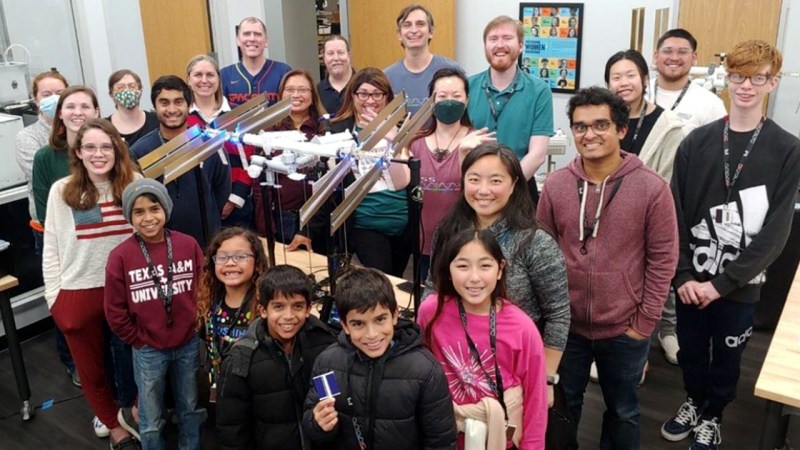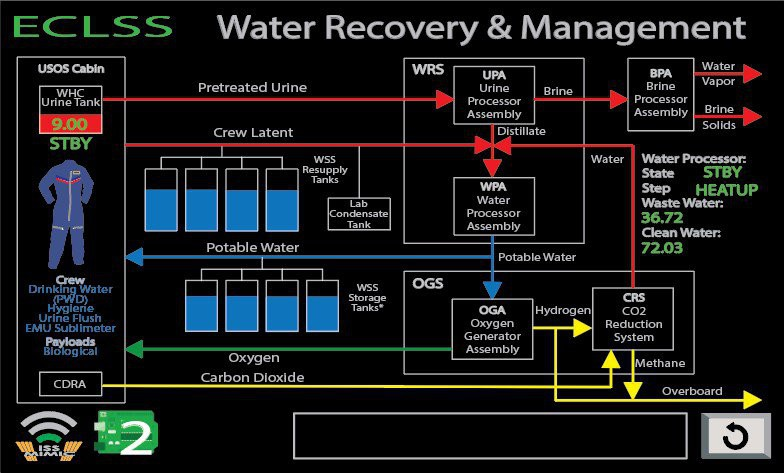Built at a cost of more than $150 billion over the last twenty-five years, the International Space Station is arguably one of humanity’s greatest engineering triumphs. Unfortunately, unlike Earthly construction feats such as the Hoover Dam, Burj Khalifa, or the Millau Viaduct, you can’t visit it in person to really appreciate its scale and complexity. Well, not unless you’ve got the $50 million or so to spare to buy a seat on a Dragon capsule.
Which is why the team behind the ISS Mimic project are trying to make the ISS a bit more relatable. The open source project consists of a 3D printable 1:100 model of the Station, which is linked to the telemetry coming down from the real thing. A dozen motors in the model rotate the solar arrays and radiators to match the positions of their full-scale counterparts, while LEDs light up to indicate the status of various onboard systems.
To learn more about the ISS Mimic, team members Bryan Murphy, Sam Treadgold, and Tristan Moody stopped by this week’s Hack Chat to bring us up to speed on the past, present, and future of this fascinating project.
Sifting Through the Data
Bryan and Sam both worked to support the real ISS at NASA, which gave them a unique insight into the Station’s daily operations. They also were well acquainted with the ISS telemetry feeds being beamed down to Earth from the Tracking and Data Relay System Satellites (TDRSS). These are made available to the public, and NASA even offers a few official ways to visualize and interact with the data. But the team thought there was potential to make all those rapidly changing fields of data come alive in a way that hadn’t been done before.
Wrapping the raw telemetry data up into visually exciting status pages gives important context, and turns what’s essentially a spreadsheet into something that looks like it could be out of a video game — something that’s particularly appealing to younger audiences. With a Raspberry Pi and small display, users are able to quickly flip through a collection of these status pages that cover a wide range of Station functions.
Building the Model
While the visualization screens are already a big improvement over the raw telemetry data, the ISS Mimic project is really about the 3D printed model itself. The team has been working on recreating each and every module of the Station in CAD — first in a “LoFi” version which is little more than a properly sized cylinder, and then later on, a high resolution version that includes accurate surface details. Where applicable, modules use magnets so they can be easily attached and potentially rearranged if needed.
 To make the model move, Bryan explains that they’re currently using geared DC motors with Hall effect sensors, which are in turn controlled by an Arduino and some custom PCBs. But between their cost and complexity, he says they’re hoping to eventually move over to continuous rotation servos, assuming they can find ones small enough to fit into the printed model.
To make the model move, Bryan explains that they’re currently using geared DC motors with Hall effect sensors, which are in turn controlled by an Arduino and some custom PCBs. But between their cost and complexity, he says they’re hoping to eventually move over to continuous rotation servos, assuming they can find ones small enough to fit into the printed model.
Ultimately, the goal is to have schools and other institutions build their own ISS Mimics, so keeping things as cheap and simple as possible is the name of the game. In fact, in response to the feedback they got from teachers, the team is currently working on a “Mini Mimic” that’s half as large and easier to print and assemble. This smaller version is still in development, but has already been assembled by a few schools over the summer.
Sam mentions that the team is also looking into more ways to make the model come alive. One suggestion was to add appropriately positioned LEDs that will blink when the Station is firing its maneuvering thrusters. He’d also like to add the Mobile Servicing System, a robotic platform that moves along a railway that stretches the length of the Station’s main truss. Like the solar arrays and radiators, this would be motorized so synchronize its position on the model with the real-world version in orbit.
Towards the end of the Chat, it was suggested that the Hackaday community should build its own ISS Mimic. Various modules and systems could be assigned to volunteers, and then the final model could be assembled during Supercon. With less than a month to go before we convene in Pasadena on November 3rd, it’s not something that we’d be able to pull of this year. But of course, there’s always 2024…
We’d like to thank Bryan, Sam, and Tristan for joining us in the Hack Chat and answering the community’s questions about this ambitious endeavour. We’re excited to see where the ISS Mimic goes from here, and will keep a close eye on its development. Since a trip to the real Station seems out of the question, this might just be the next best thing.
The Hack Chat is a weekly online chat session hosted by leading experts from all corners of the hardware hacking universe. It’s a great way for hackers connect in a fun and informal way, but if you can’t make it live, these overview posts as well as the transcripts posted to Hackaday.io make sure you don’t miss out.

















Outside of the fact you could not float through it, it would be cool for one of the science museums to build a 1:1 replica of the space station just to get a feel for what is out there.
+1 Especially, as long as the ISS is still up there, to fascinate both the young and those young at heart. Otherwise, it’s just an experience as with Arecibo: Let’s imagine somewhere at a random location there’s a neat museum’s piece in an exhibition without the real thing still being in existence. It wouldn’t be the same.
The used to have a Skylab exhibit in the Air & Space Museum. It was cool even after Skylab deorbited.
That exhibit is the actual Skylab B backup station. They considered it launching it for a second station, but funding was getting scarce, and Saturn Vs were getting scarcer. Probably the single greatest donation the museum has ever been given.
On the 42nd page of this PDF is a dimensioned drawing of the isogrid pattern used in walls and floors of Skylab. https://femci.gsfc.nasa.gov/isogrid/NASA-CR-124075_Isogrid_Design.pdf
Unfortunately this PDF was scanned from a printout that seems to be from old microfiche or microfilm, and that was likely made from an old FAX or photocopy that couldn’t do greyscale.
I hope that someone, somewhere, has an original copy of NASA CR-124075 Isogrid Design Handbook.
At least with this info one can “space up” a place with a dimensionally accurate copy of what was used in Skylab. I assume they NC milled and drilled the grids from solid aluminum sheet. Lots of waste that way. If such a grid was made today the triangles would likely be abrasive waterjet cut.
When I visited Kennedy Space Center (~20 y. a.) there was a ISS module on display. It may have been mockup that had been used for training, drawers (lockers) above, below and each side, and other stuff (workstations?) that I don’t recall.
So, is this a physical-digital twin?
Should adapt this to my LEGO ISS
All very cool. I use a number of apps to track the ISS and when it’s overhead at night, I like watching it zip across the sky. When looking at the telemetry data items, I think they need a few hundred more discrete items to track :) Of the graphics, I was less than enthusiastic about seeing the loop from the urine tank to potable water.
” the International Space Station is arguably one of humanity’s greatest engineering triumphs ” , and the greatest total waste of money! What have we learned and applied down here on earth that equals that money spent ? Nothing… Just a bunch of dreamers wasting my tax dollars.
Yours is a common question. I think some of the things learned include advances in mathematics, physics, biology, communication, materials development, fuels, human/material environmental tolerances. Not to mention the vast number of people employed by NASA and its contractors/subcontractors. All of this may not be obvious nor directly benefit you but I believe it benefits mankind.
One problem with government projects is that _everything_ is a jobs program.
The fact that it keeps politician’s idiot relatives busy and out of prison is not that great a benefit.
(Hunter/Chelsea/Don Jr./the Bush, Gore, Mao and Putin clans) could all be productively digging ditches somewhere.
Are you sure you are reading the right website, Mike??
We’ve sent at least twice that amount, and some estimates say 5x as much to Ukraine in 2 years. We’ll never see returns on that money, but as @MmmDee pointed out, we have gained a lot of information from the space station. I’d call $25 Billion an excellent investment.
With the way the US is spending money, $25 billion is a rounding error.
I like Chutzpa.
Printing trillions of dollars and calling the mess ‘the Inflation Reduction Act’ is the new definition of Chutzpa.
Too bad they wasted the money, but ‘nature or a scorpion’…They are getting what they voted for, real hard, no lube.
Putin not ruling the world seems like a great return on the money.
If we are ever to reach the stars, the space station is a good starting point. Next the moon, then Mars, then…. Not a waste of money at all to focus on the last frontier. Otherwise, we will stagnate and start going backwards. No the search for new materials, new medicines, growing things in space, robotics, new ways to propel our space craft, protect our space craft, etc., and the men in them, all benefits mankind. You might say it expands the mind to new things. Money well spend. And a drop in the bucket compared to the mostly unnecessary social programs and such that are out there when you look at the total GDP.
Neat model BTW. Lots of work went to the design and implementation. Kudos.
“Just a bunch of dreamers wasting my tax dollars.”
I’m sorry, but it seems the intellectual maturity here isn’t upto the topic yet.
Taxes are nothing to save up, they are meant to be spend. More precisely, in a way that benefits the citizens in some way. It’s not your tax. You paid a fraction of Cent, at best, so don’t worry. And the ISS did pay off. Multiple ways. Sofar.. It helped bettering the reputation of your country. The international corporation secured peace, especially with Russia. The ISS gave the youth something to aim for, to dream about. It gave hope. It forced the media “to look down” to earth as a whole. That way, it provided a mirror to society. Whenever astronauts look down and report about wildfires, hurricanes and other catastrophes. Then, there’s science and research in microgravity. Things neither you nor me fully can comprehend.
That’s pretty neat. Family might not think much of one in the living room, but I still want.
It’s missing a few of degrees of freedom though: It would be very cool to change the whole model’s orientation to match the ISS. Here it appears to just be static.
Wasn’t here a month or two ago another model showing real time position and configuration made by people from NASA?